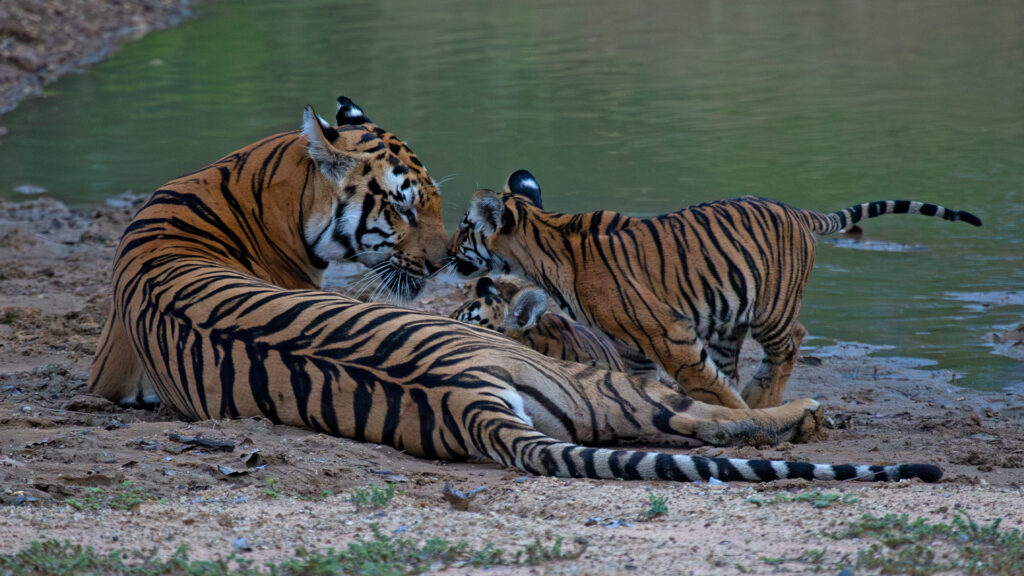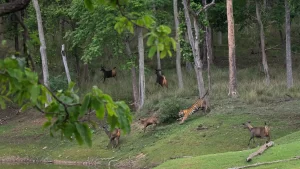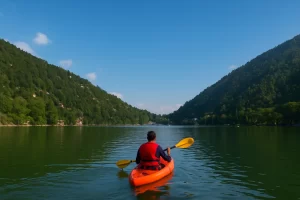Tiger Conservation in Tadoba: Remarkable Ways to Save Bengals
AnirbanNS

Tadoba has a story that surprises many. Once known as a hunting ground, it has now turned into one of the strongest examples of tiger conservation in India. Often called the Jewel of Vidarbha, this reserve is not only about spotting the Royal Bengal Tiger but also about witnessing how people, forest staff, and nature lovers came together to protect wildlife. From the calm Tadoba Lake to the deep green forests and valleys, every corner here tells the journey of Tiger Conservation in Tadoba.
Evolution of Conservation in Tadoba
Amid the dense volume of this reserve, Tadoba has an interesting history to it between 1000 BC and 1879 AD. The tribal people lived in Tadoba for hundreds of years. Living in perfect harmony with the wildlife, there came a time when the chief of the village, Taru, was attacked and killed by a tiger. The subjects of his tribe built a memorial in honour of the village chief near Tadoba lake.
The Britishers then occupied Tadoba between 1879 and 1935. This period witnessed Tadoba turning into a resource extraction forest where wildlife hunting was also carried but it went unchecked. Finally, tiger shooting was banned in 1905, excluding those who had special permits to carry out hunting. Further strict restrictions on hunting animals were applied in 1931, which marked a significant establishment of conservation efforts.
By 1935, the Tadoba region was established as a wildlife sanctuary to address the ecological concerns. Also, to work on the alarming reduction in the tiger population, such as the endangered species of the Royal Bengal Tiger. However, due to continued illegal hunting, the Tadoba National Park was formed in 1955 for Tiger Conservation in Tadoba.
Conservation Strategies implemented
Innovative efforts were introduced after the Tadoba Andhari Tiger Reserve was formed.
- Anti-poaching patrols were sharpened.
- Habitat management programs were established.
- Local communities were educated on the significance of wildlife preservation.
As a result, the tiger population gradually increased, giving positive results to the overall ecological system.
The matter of fact is that poaching and hunting of tigers continues to remain a challenge. Therefore, more measures are applied more strictly to improve tiger conservation in Tadoba, such as:
- Anti-poaching measures
- Forest rangers continue to keep a check by travelling through the region daily.
- Addition of surveillance cameras to identify and catch potential poachers and hunters in the Tadoba forest.
- Trained dogs are deployed to track and identify potential poachers.
- A special task force is assigned to investigate and bring poaching crimes to justice.
- The reserve’s habitat restoration
-
- Reforestation to enhance the forest’s volume and density, which is essential for the survival of tigers.
- Maintaining an appropriate environment to enhance the thriving state of the tigers.
- Water conservation
- Actionable steps for land restoration
- Public awareness
Local communities are encouraged to take part in the conservation efforts. This includes making sure that the communities understand the need for tiger protection and how to live harmoniously with this wildlife wonder.
Biodiversity and Ecosystem of Tadoba
The natural habitat of this reserve contributes to the rich biodiversity, and it is what magnetises Tadoba tourism. Let’s explore this ecosystem to understand what makes it one of the best Maharashtra Wildlife reserves among others.
The Tadoba Andhari Tiger Reserve encompasses densely occupied forests, water bodies, and grasslands. It is a safe space for tigers, sloth bears, leopards, Indian bison, wild dogs, deer, antelopes, and 200+ bird species, including the endangered Indian vulture.
Balancing Tadoba Tourism with Tiger Conservation in Tadoba, India
Relevant measures are taken to ensure that tiger conservation in Tadoba is maintained at its peak. This includes trained naturalist guides, limited entry permits, and strict safari rules that assist in maintaining the reserve’s integrity.
These measures ensure that the safari visitors can enjoy the beauty of the wildlife around them. At the same time, everyone respects the significance of the ecosystem. This is because, beyond the Royal Bengal Tiger, this national park is known for its endangered species and rare ones too, such as the Indian Giant Squirrel and Indian Pangolin.
The Tadoba Andhari Tiger Reserve is also a must-visit due to its scenic beauty and the weather. Firstly, the lakes here bring a calm and peaceful aura to the place, which are the Andhari River, the Tadoba Lake, and the Kolsa Lake. Secondly, the weather is clear most of the time, rising above 40 degrees Celsius with minimal rain. So, safari visits here are easier as long as you carry the necessary items to protect yourself from the heat. That said, with the warm days come cool nights as temperatures drop below 10–15 degrees Celsius during winter, making the experience of Tiger Conservation in Tadoba even more memorable.
Successes and Ongoing Challenges in Tiger Conservation
Maintaining tiger conservation in Tadoba has seen an uphill success, although it is not shy of its challenges. The forest has witnessed human-wildlife conflict, habitat degradation, and poaching. While there continue to be threats, the measures taken have ensured plant and wildlife preservation at its highest.
Some of the key milestones this reserve has seen include:
- 1955: The Tadoba National Park was founded
- 1995: Combining the Andhari Wildlife Sanctuary and the Tadoba National Park to make the Tadoba Andhari Tiger Reserve
- 2007: Securing modern safari amenities, trained naturalist guides, and manned entry points.
- 2010s: Executing online Tadoba safari booking to increase global tourist accessibility
Through these years, the reserve has successfully crossed major finish lines:
- Gradual growth of the tiger population in Tadoba by overcoming poaching and hunting.
- Revenue from Tadoba Tourism has fueled the conservation of tigers, wildlife, and community development.
- Tourists remained educated about their responsibility towards their visit, reducing any major impact on the environment.
Iconic Tigers of Tadoba: Symbols of Conservation
The Royal Bengal Tiger stands to be a dazzling beast of its kind. However, apart from this magnificent creature stand other iconic tigers as well, such as the:
- Maya – Queen of Tadoba: Spotted in Navegaon and Kolara ranges, Maya is popularly known as the Queen of Tadoba.
- Gabbar – The Scar-faced Warrior: A scar-faced male tiger, was seen fighting with male tiger to grab and claim his territory.
- Madhuri – The Supermom : Known as the supermom of Tadoba, Madhuri has given birth to 19 cubs. Her daughters — Mona, Lara, Geeta, and Sonam — have even been featured in a wildlife documentary.
- Choti Madhu: Madhuri’s daughter, too, who was given a specific section of the land by her mother to live there.
- Others: Bajrang, Chota Matka, Kanika Jhari, etc. Bajrang, Chota Matka, Kanika Jhari, and many more continue to thrive in the reserve.
Conclusion
Tiger conservation in Tadoba is something that truly leaves you in awe. A place that was once known for hunting has now turned into a safe home for the Royal Bengal Tiger and so many other wild species. Tigers like Maya and Gabbar are the pride of this forest, but the reserve is also full of leopards, sloth bears, wild dogs, and colorful birds.
Tadoba is proof that nature can bounce back if we protect it. As visitors, the best thing we can do is enjoy the safari, respect the rules, and spread the word about saving wildlife. When you come to Tadoba, you’re not just here for a jungle trip — you’re also adding to the future of the tigers.
Frequently Asked Questions About Tadoba Andhari Tiger Reserve
Q 1. Which is the largest tiger conservation area in India?
– Tadoba Andhari Tiger Reserve is one of the biggest and most popular tiger reserves in India, spread across 1,727 square kilometers in Maharashtra. Other reserves like Jim Corbett and Sundarbans are also large, but Tadoba is especially famous for its high chances of tiger sightings and strong conservation work.
Q 2. How many tigers are there in Tadoba Andhari Tiger Reserve?
– Recent reports suggest that Tadoba has around 115 tigers, including adults and cubs. This number has grown over the years thanks to strict protection and continuous conservation efforts.
Q 3. Which animals can be found in Tadoba apart from tigers?
– Tadoba is full of wildlife. Along with the Royal Bengal Tiger, you can spot leopards, sloth bears, wild dogs (dholes), Indian bison (gaur), deer, antelopes, and even marsh crocodiles. Bird lovers can enjoy over 200 bird species, including the endangered Indian vulture. Rare creatures like the Indian Giant Squirrel and Indian Pangolin also live here.
Q 4. Why is tiger conservation in Tadoba important?
– Tigers play a big role in keeping the forest healthy. They control prey numbers and help maintain balance in the ecosystem. Saving tigers in Tadoba also means saving the forest, rivers, and other animals. Plus, tiger conservation creates jobs for locals and supports eco-tourism, which benefits nearby communities.
Q 5. Can tourists support tiger conservation while visiting Tadoba?
– Yes, definitely! By booking safaris through official portals, you’re directly helping conservation projects. Following the park rules—like not littering, keeping quiet during safaris, and respecting the guides—makes a big difference. Sharing your experience with others also spreads awareness about protecting tigers.
Q 6. How does Tadoba balance tourism with tiger conservation?
– Tadoba keeps a fine balance by allowing only a limited number of safari vehicles each day, using trained naturalist guides, and restricting entry to certain zones. This way, tourists can enjoy the forest without disturbing the tigers. The money collected from tourism is used for anti-poaching patrols, habitat improvement, and community welfare.
Q. 7 What makes Tiger Conservation in Tadoba successful?
– Tiger conservation in Tadoba works well because of strict protection, modern safari management, and support from local communities. The merging of Tadoba National Park and Andhari Sanctuary in 1995 also played a big role.







